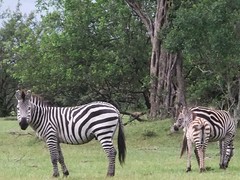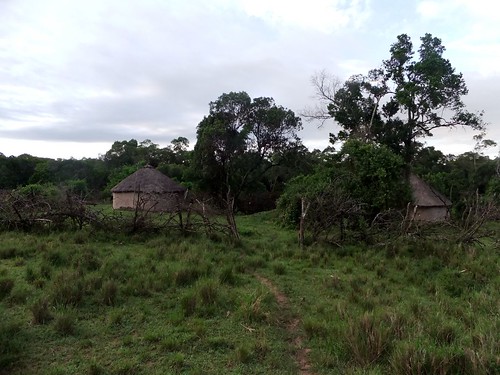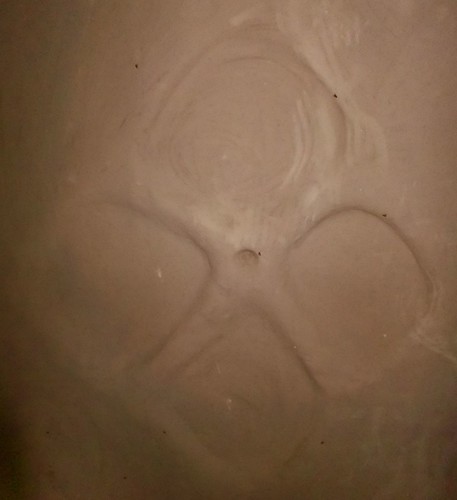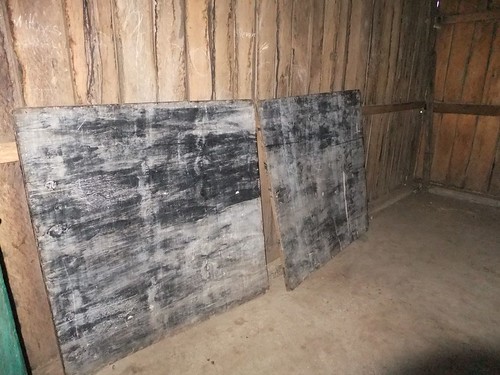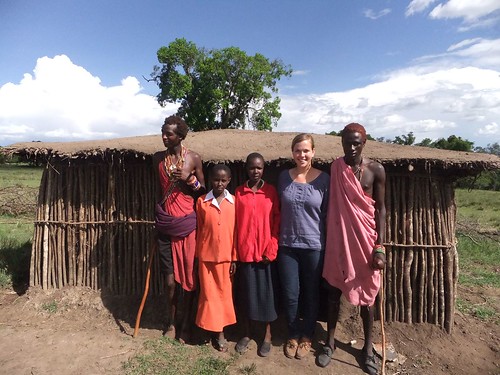A couple of weekends ago, I made a trip that involved 3 matatus, 4-5 hours on the road, and culminated in an hour and a half walk into the deep forested bushland adjacent to the Maasai Mara. Passing the last big town (although it lacks a bank and pretty much every service that implies somewhere is a “big town”), Lolgorian, I started to see a sea of Maasais that had I not known better, I would have thought were dressed just for tourists because of the proximity to the Maasai Mara. Mama Kakenya, my traveling companion, chuckled and told me I had thought I lived in a maasai village, but now I should see that this is real maasailand, and Enoosaen is practically a Maasai city: “Maasai Modern,” let’s say.
I was on my way to Perenai and Ryle’s homeland of Pusanki, mere kilometers from the official border of the Maasai Mara. Perenai and Ryle are students in standard 4 about whom I wrote earlier. I had found their stories of going to school past wild animals in the Mara so interesting that I knew I had to visit them at home over the April holiday. I had a fantastic time playing tourist and undercover researcher, and bwana, did the plot thicken.
It turns out that in Pusanki there are several reasons that children are kept home from school beyond just the threat of roaming animals. For girls of course, this includes the devaluing of females and girls’ education. For instance, out of the 16 students in the eighth grade at the local primary school, only 3 are girls. At a regional mixed gender boarding school which serves a much larger area around Pusanki, only 15 of the 80 eighth graders are girls… by that point most girls have been cut, married and taken out of school.
Some of the challenges to educational achievement are gender blind – I met several boys in their 20s who are still in primary school.
The deeper one goes into the “interior” of the rural communities, the educational prospects become even more dire.
I also met a pastor whose 17 year old daughter is in standard 6 because although he cares deeply about education, until they moved close enough to the river she was kept out of school in years of drought when the whole family would have to pick up and move. Often families in Pusanki don’t send children to begin school at a young age because in order to be safe while walking they first have to be able to identify wild animals in the bush and differentiate an elephant leg from a tree at a distance. Even if you are allowed to walk to school (you are old enough and there haven’t been any recent sightings of especially dangerous animals in your direct line to school) you cannot begin your walk to school until well into the school day for safety reasons (meaning you might leave on your 2 hour journey at 10 am and barely arrive at school before you have to leave again). So even if a child does begin school at the appropriate age, the likelihood is that he or she will miss so much school due to these obstacles that the child will have to repeat one or several years of school. Furthermore, and especially until the past 5 or 10 years, the people of this area have had an overall lack of appreciation of the value of education at all.
But it is girls who undoubtedly bear the largest burden.
Early marriage of girls is visibly much more prolific around Pusanki than around the centre of Enoosaen and Keyian Division. Girls who would run away from home to avoid FGM or marriage find little support among their neighbors, but they do have one recourse, a local representative from World Vision. It is to this representative, Kennedy, that a pastor will send a girl if she turns up at his door step. Kennedy investigates the situation, and may attempt to reconcile the girl with her family. If reconciliation seems impossible, Kennedy swiftly sends them to a World Vision rescue center which will help with their schooling in Kiriondoni, about 25 km away (Hopefully I’ll be able to visit the rescue center during my tenure here…). Still, Kennedy told me that extreme social pressure not to run away exists in this area, and that despite their best efforts to hold educational seminars, World Vision still expects that at least 70% of girls in Pusanki undergo the cut. That cut is the gateway to marriage and the exit path from school, the landmine in a girl’s trajectory towards success and liberation or continued oppression.
It also turned out to have been quite a task to have Perenai and Ryle admitted to the school in the first place. First of all, the distance is such that the transportation fee to the interview alone could have been prohibitive were is not for these parents’ dedication to getting a better start for their children. Secondly, it turns out that when Ryle’s mother first suggested the school to several of the parents in Pusanki, she was vociferously turned down. She was taking their girls too far away, they told her, as they called her names. But Mama Ryle is a soft-spoken force to be reckoned with. Despite being a widow and the single income earner in her household, she has managed to put all of her elder children through high schools – something very uncommon in this area. So, she relentlessly pushed the idea of sending Pusanki’s girls to the Enkakenya Centre for Excellence. By the time she approached Perenai’s family, she had been turned down several times and had learned her lesson: don’t approach the mother first, as they are had been the most resistant even when fathers would have been willing to send their children.
Mama Ryle told Perenai’s father, who agreed, but up until the last minute Perenai and her father did not tell the mother that Perenai would be leaving for school. Although her mother was extremely upset at the time, having seen her daughter come home as a healthy and composed sweet young scholar, she is now very proud to have her daughter going to the Enkakenya Centre.
Last time I wrote about how boarding school for Maasai girls simply means enough time to go to school and study without the added burden of two walks to and from school and inordinate amounts of housework that boys are mostly spared. For Ryle and Perenai, it is not just boarding school, but a better quality learning environment that is making a difference when compared to what they have available at home. The response from their community upon their return during the April holiday sends this message loud and clear; like Perenai’s mother, those who were initially resistant to and rude about the idea of sending the girls away to school are now ogling the progress the girls are making. This holiday was the girls’ first visit home since their departure, and I suspect that their arrival in their beautiful newly gifted uniforms was enough to get them some envious glances. Beyond that, locals who don’t even know the girls have gone away to school are asking about how healthy and beautiful the girls look (a likely result of their better quality diet and time away from manual labor to study and rest). Everybody wants to send his or her child to the school – several even asked if they could go ahead and send their children away with Mama Kakenya and I.
Overall, things have changed significantly for the girls and their formerly-considered-to-be-heretic parents since they’ve come home. What I love is that not only is the message about the prestige of sending a girl away to the Enkakenya Centre, but the prestige of having a well educated daughter. I like to think that this part of the Enkakenya Centre’s impact that may in fact be the most enduring.
I wrote before about my current frustration with what is sometimes a lack of community investment in the project in Enoosaen. My visit to Pusanki exposed this issue even further because the community passion for elevating their level of education in Pusanki is such a contrast to what I’ve seen here in Enoosaen. Having heard what Kakenya has done in Enoosaen, and probably presuming that since I am a muzungu I also have something to do with the purse strings, people made it clear, without asking for anything, how desperately they want more schools in their area. If someone would help them build a school, they would donate the land, they say. If someone would help them buy materials, they would go out and gather the locally available resources like stones and sand with their own hands. And then they would help with the labor themselves. Knowing that a school like ours only accepts a small number of girls of a specific age, what if a school like that came here, I asked? Would you still be willing to help if your child weren’t eligible? The answer was a resounding yes, because, they say, if they don’t have a eligible daughter now, they may one day, or their son’s daughter may one day be eligible – the people I spoke to in Pusanki don’t seem overly focused on immediate gratification.
My suspicions about what you can get for your money in building in Pusanki were confirmed when I spoke to someone from the district’s Constituency Development Fund office, which gives grants for projects just like school construction. He told me that the people in the more developed areas, people ask for 600,000 Ksh ($7,500) to build a single classroom, but that in Pusanki they only need 200,000 and they make the money go much further. “If I gave them 600,000, in three months they would show me three classrooms,” he jested.
All of this says two things to me. First, this area could benefit hugely from a school like Kakenya’s, and as you can see, the fact that it is a boarding school would make even more difference. Second, I’ve noticed an interesting pattern here in Kenya whereby once a place or person has a little education, there are more political rankles amongst the people who do have some power, position, or wealth. A person uses their slightly elevated stature to impress their supposed superiority upon those with less education, and to try to grasp onto those at the top, with much more education or wealth. And sadly, I am told by friends, this behavioral trend does often seem to get in the way of a community’s own development.
Some of the highlights of the trip were definitely the aspects of the very traditional lifestyle I got to witness first hand. The most exhausting of which was the massive distances people walk to get anywhere.
One’s “boma” (similar to a farmstead of sorts) might be at least an hour apart from one’s closest neightbor’s. The “town” centre of Pusanki is a two-hour walk from Mama Ryle’s through expanses of bush and savannah that to me have hardly any directional signs or paths other than the direction of that burning sun. This is the kind of remote place where the only available clinic to most people is a once monthly mobile clinic that comes to the town of Kawai, an hour and a half away. No wonder the Maasai need such long legs.
I got to see (but not sleep in!) traditional beds that are just a raised mud platform (“built in furniture” for the traditional mud house) covered in a cow skin. I was given a fantastic beaded rungu to pass on to my father. I walked among gazelles, antelope, and herds of wild Zebra intermingling with the herds of grazing cows…and heard the lion’s roar (from “very far away”) in the night.
I also got to see and greet (and take tourist photos with) morans – the age set of young men who go off and live together in an isolated grouping of specifically built houses after their circumcisions. They are ostensibly training to be warriors and learning how to protect their people and their people’s cows, but they seem to spend a lot of time doing their hair, eating, and bringing in young women. It is a beautiful tradition in the beads and adornments but I don’t like what it stands for: never, ever in this culture would years of time be set aside for women to preen and make merry like the morans.
To my surprise, even Mama Kakenya said she had never been to a Maasai home quite as deep in the bush as this. I’m so lucky to have had insider access to this in my meager 2 months here, considering Mama has been here for…well, a long time. I would take a trip to Pusanki over a safari in the Mara any day – the conversations about education are so much more stimulating.
Posted By Charlotte Bourdillon
Posted May 23rd, 2011


